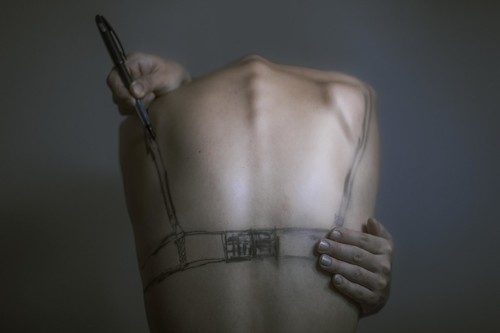'For people in my profession it is normal to walk along with your mind on other things: the article you have to write, the lecture you must give, the relationship between the One and the Many, the Andreotti government, how to deal with the problem of the Redemption, whether there is life on Mars, the latest song of Celentano, the paradox of Epimenides. In our line this i called "the interior life." Well, with my new jeans my life was entirely exterior: I thought about the relationship between my pants and me and the society we lived in. I had achieved heteroconsciousness, that is to say, an epidermic self-awareness.
I realized then that thinkers, over the centuries, have fought to free themselves of armor. Warriors lived an exterior life, all enclosed in cuirasses and tunics; but monks had invented a habit that, while fulfilling, on its own, the requirements of demeanour (majestic, flowing, all of a piece, so that it fell in statuesque folds), it left the body (inside, underneath) completely free and unaware of itself. Monks were rich in interior life and very dirty, because the body protected by a habit that, ennobling it, released it, was free to think, and to forget about itself. The idea was not only ecclesiastic; you have to think only of the beautiful mantles Erasmus wore. And when even the intellectual must dress in lay armor (wigs, waistcoats, knee breeches) we see that when he retires to think, he swaggers in rich dressing-gowns, or in Balzac's loose, drôlatique blouses. Thought abhors tights.
But if armor obliges its wears to live the exterior life, then the age-old female spell is due also to the fact that society has imposed armors on women, forcing them to neglect the exercise of thought. Woman has been enslaved by fashion not only because, in obliging her to be attractive, to maintain an ethereal demeanor, to be pretty and stimulating, it made her a sex object; she has been enslaved chiefly because the clothing counseled for her forced her psychologically to live for the exterior. And this makes us realize how intellectually gifted and heroic a girl had to be before she could become, in those clothes, Madame de Sévigné, Vittoria Colonna, Madame Curie, or Rosa Luxemburg. The reflection has some value because it leads us to discover that, apparent symbol of liberation and equality with men, the blue jeans that fashion today imposes on women are a trap of Domination; for they don't free the body, but subject it to another label and imprison it in other armors that don't seem to be armors because they apparently are not "feminine." '
Travels in Hyperreality
(Reading Things
Sub-chapter: Lumbar Thought)
(Pages 193-195)




Post a Comment